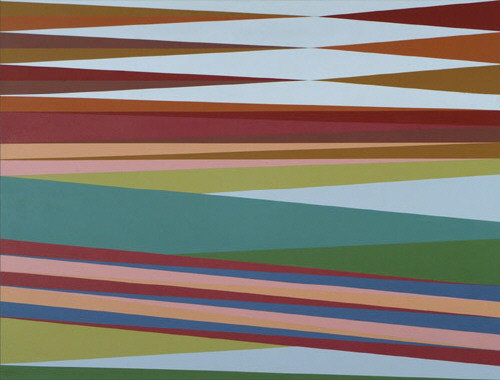Two exhibitions
dal 17/11/2006 al 21/12/2006
Segnalato da
17/11/2006
Two exhibitions
Jack Shainman Gallery, New York
Odili Donald Odita addresses a newfound complexity. Recent canvas paintings and wall paintings bridge many distinctive visual parts into a multi-faceted whole, while exploring color in all its multitudinal permutations. Martha Camarillo' s photographs document life in a horse-racing neighborhood that is located in the heart of Philadelphia.

Odili Donald Odita
Fusion
In his first one-person exhibition titled, Fusion, at the Jack Shainman Gallery,
Odili Donald Odita addresses a newfound complexity. Recent canvas paintings and wall
paintings bridge many distinctive visual parts into a multi-faceted whole, while
exploring color in all its multitudinal permutations. Within the context of
installation, Odita continues his primary investigation of color through what the
artist calls a third space.' The painting that gives the exhibition its title,
"Fusion" makes its case evident.
This painting, like a stitched or quilted textile, is a weaving of two different
spaces, of two different times and temperaments brought together along a single
vertical line made by the abutment of these two patterned fields. This invisible
vertical line becomes the fissure that separates as it conjoins a flash point
where two vibrant color fields become one.
For Odita, color in itself has the possibility of mirroring the complexity of the
world as much as it has the potential for being distinct. In his large-scale
paintings we see color interwoven and mixed, becoming an active agent in
representing the essential power that light has in identifying the entirety of our
world. To quote the artist directly from his statements on color: "What is most
interesting to me is a fusion between cultures where things that seem faraway and
disparate have the ability to function within an almost seamless flow. The fusion I
seek is one that can represent a type of living within a world of difference. No
matter the discord, I believe through art there is a way to weave the different
parts into an existent whole, and where metaphorically, the notion of a common
humanity can be understood as a real choice."
Odili Donald Odita was born in Enugu Nigeria and lives and works in Philadelphia and
New York. Odita is currently an Associate Professor of Painting at Tyler School of
Art, Temple University in Philadelphia, and from 2003-2005 he was a Visiting Critic
in Painting at Yale University School of Art. In the past ten years Odita has
exhibited extensively at some of the most important venues in the world. Odita
currently has work on view in the traveling exhibition, "A Fiction of
Authenticity," which inaugurated the newly designed Contemporary Art Museum in St.
Louis. Recently, his work was featured in "Big Juicy Paintings and More:
Highlights from the Permanent Collection", Miami Art Museum, Miami, FL,
"Ordering and Seduction," curated by Dorothea Strauss at the Haus Konstruktiv,
Zurich, "The Shape of Colour: Excursions in Colour Field Art, 1950 2005,"
curated by David Moos at the Art Gallery of Ontario, "Surface Charge," curated
by Gregory Volk and Sabine Russ at the Anderson Gallery, Virginia Commonwealth
University. In 2004, Odita represented North America at DAK'ART, the Dakar
Biennale of Contemporary African Art. Odita received the Thami Mnyele Foundation
Residency Grant in Amsterdam for African Artists in 2004; a Joan Mitchell Foundation
Grant in 2001; an ArtsLink Collaborative Projects Award in 2000, and a Penny McCall
Foundation Grant in 1994.
----
Martha Camarillo
Fletcher Street
The Jack Shainman Gallery is proud to present Fletcher Street, an exhibition of
photographs by the artist Martha Camarillo. The works in Fletcher Street document
life in a horse-racing neighborhood that is located in the heart of Philadelphia.
Dating back to the early 1900's, Fletcher Street has had horse stables where
thoroughbreds were raised. Now an African-American community maintains the stables,
having built a whole way of life around this activity. Many of the stables in or
around Fletcher Street were built on small plots of inner-city land, in former
factories and warehouse spaces and sometimes in abandoned townhouses. Martha
Camarillo's photographs capture this underground, urban phenomenon portraying the
men and boys of Fletcher Street, their special bond with their horses, and the way
through which this unique tradition has provided a sense of belonging to an entire
community. "Camarillo's work is valuable not only because it illuminates a
fascinating new aspect of culture, but also because it challenges those who see it.
Her photographs force viewers to confront their own pre-conceptions of sport as
representative of social status, and race as a demarcation of class.
The power of Camarillo's exploration of this underrepresented community is based
on the strength of the men themselves: urban horsemen who have ridden away from the
hood and toward a better future."
Kathy Dobie Martha Camarillo is an internationally known photographer whose
portraits often expose hidden aspects of urban culture. Her work also focuses on the
subject of identity through portraiture. Her previous project, Remote Photos, a
collaboration with artist Avena Gallagher, was an in-depth look at the identity of
teenage male and female models, made by giving the models themselves disposable
cameras to be used however they saw fit. Originally born in Texas and currently
living and working in New York, Camarillo's work has appeared in The New York
Times, The Telegraph, Numro, Journal, i-D, and many other publications. Work from
her Remote Photos project resulted in a book published by Janvier. Camarillo was the
winner of the Hyres Festival 2001 and the 2002 Art Director's Award. Coinciding
with the exhibition Powerhouse is publishing "Fletcher Street", featuring the
full series of photographs by Camarillo.
Image: Odili Donald Odita, Parallel, 2006
Jack Shainman Gallery
513 West 20th Street - New York



